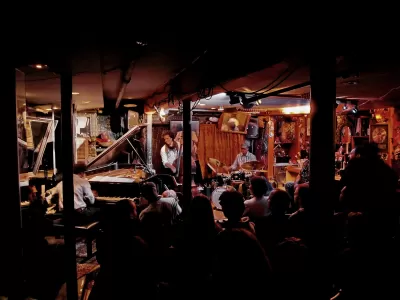A new real estate investment fund wants to help music venue owners buy their properties and stay in business as the pandemic and market forces decimate their earnings.

When the pandemic shut down live entertainment, music venues saw their revenues plummet as much as 90%, with many struggling to keep paying their bills. To help venues stay afloat, Dayna Frank, owner of First Avenue Music Hall in Minneapolis, worked with Grubb Properties CEO Clay Grubb to create "the Live Venue Recovery Fund, a pioneering program that provides eligible independent music operators with a 3 – 5 year roadmap toward purchasing their own venues." Rebecca Greenwald reports on the fund's efforts for Next City.
As renters, Frank believes, many venue owners are extremely vulnerable to "a growing affordability crisis and the whims of opportunistic landlords, and the looming threat of Live Nation’s growing influence and consolidation of the industry." The recovery fund aims to shift the balance of power and give venue operators a path to ownership. "Designed around an impact fund real estate model, the Live Venue Recovery Fund caps Grubb’s rate of return at 12%, after which any remaining returns are donated to the National Independent Venue Foundation, a nonprofit related to the National Independent Venue Association (NIVA), a trade association that was formed at the start of the pandemic."
"Rather than looking at the Live Venue Recovery Fund as an aggressive acquisition program," writes Greenwald, "Frank sees this as a resource and another option that venues have available to them as they navigate a challenging external environment."
FULL STORY: Will This Impact Fund Save America’s Music Venues?

Alabama: Trump Terminates Settlements for Black Communities Harmed By Raw Sewage
Trump deemed the landmark civil rights agreement “illegal DEI and environmental justice policy.”

Planetizen Federal Action Tracker
A weekly monitor of how Trump’s orders and actions are impacting planners and planning in America.

The 120 Year Old Tiny Home Villages That Sheltered San Francisco’s Earthquake Refugees
More than a century ago, San Francisco mobilized to house thousands of residents displaced by the 1906 earthquake. Could their strategy offer a model for the present?

In Both Crashes and Crime, Public Transportation is Far Safer than Driving
Contrary to popular assumptions, public transportation has far lower crash and crime rates than automobile travel. For safer communities, improve and encourage transit travel.

Report: Zoning Reforms Should Complement Nashville’s Ambitious Transit Plan
Without reform, restrictive zoning codes will limit the impact of the city’s planned transit expansion and could exclude some of the residents who depend on transit the most.

Judge Orders Release of Frozen IRA, IIJA Funding
The decision is a victory for environmental groups who charged that freezing funds for critical infrastructure and disaster response programs caused “real and irreparable harm” to communities.
Urban Design for Planners 1: Software Tools
This six-course series explores essential urban design concepts using open source software and equips planners with the tools they need to participate fully in the urban design process.
Planning for Universal Design
Learn the tools for implementing Universal Design in planning regulations.
Clanton & Associates, Inc.
Jessamine County Fiscal Court
Institute for Housing and Urban Development Studies (IHS)
City of Grandview
Harvard GSD Executive Education
Toledo-Lucas County Plan Commissions
Salt Lake City
NYU Wagner Graduate School of Public Service





























